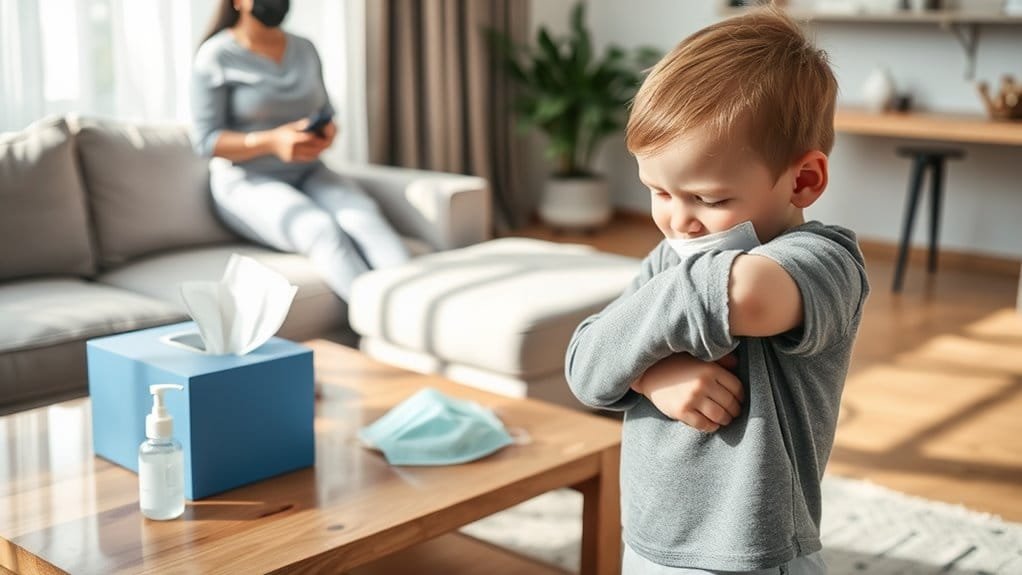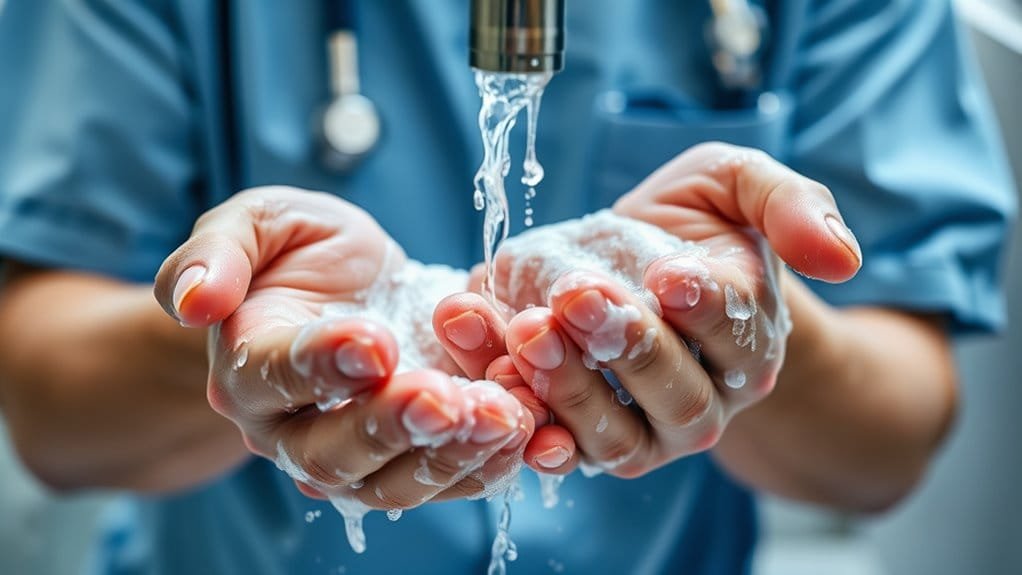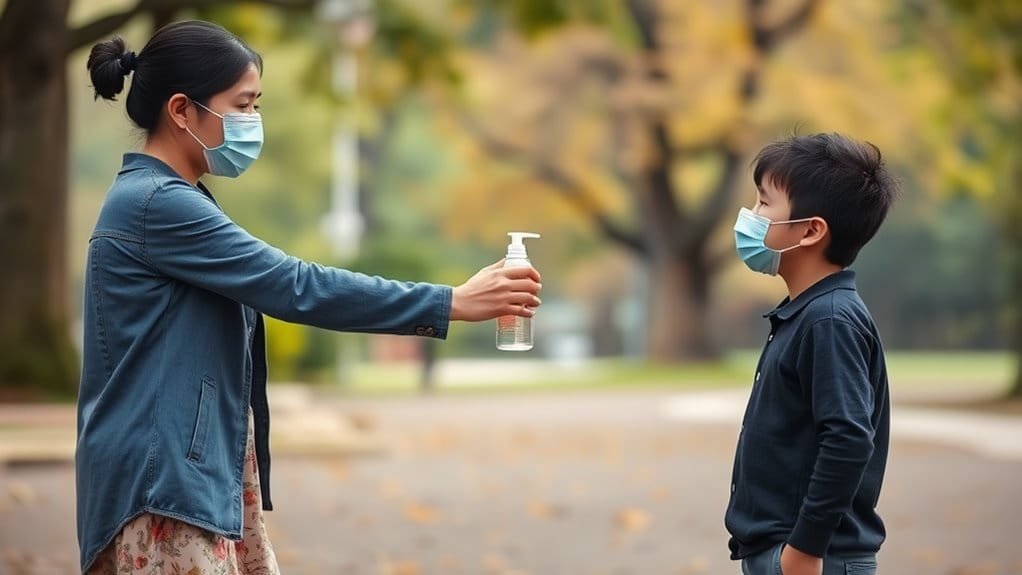To protect yourself from HMPV, you need to adopt a few simple yet effective habits. First, make hand hygiene a priority – wash your hands frequently with soap and water for at least 20 seconds, or use an alcohol-based sanitizer if soap is unavailable. Next, practice good respiratory etiquette by covering your mouth and nose when coughing or sneezing with a tissue or your elbow. Avoid close contact with anyone showing respiratory symptoms and keep at least 6 feet of distance in crowded spaces. By following these steps, you can considerably reduce your risk of HMPV infection, and that’s just the beginning of safeguarding your health effectively.
Key Takeaway
- Wash hands regularly with soap and water for at least 20 seconds, especially after using the bathroom and before eating.
- Cover mouth and nose when coughing or sneezing using tissues or elbows to prevent germ transmission.
- Maintain social distance of at least 6 feet from others, especially in crowded areas and during late winter and early spring.
- Clean and disinfect frequently touched surfaces and objects with soap and water or sporicidal disinfectants.
- Stay home and rest when sick, ensuring adequate hydration and using medications like acetaminophen or ibuprofen for symptom relief.
Understanding HMPV Transmission

Human metapneumovirus (HMPV) transmission occurs primarily through direct contact and airborne routes.
You’re at risk when you engage in physical interactions like kissing, touching, or shaking hands with an infected individual. HMPV thrives on surfaces for several hours, making indirect contact transmission a significant concern. If you touch contaminated surfaces and then touch your mouth, nose, or eyes, you could become infected.
Airborne transmission is another common mode for spreading HMPV. When an infected person coughs or sneezes, they release droplets that contain the virus into the air.
If you’re in close proximity to an infected individual, you’re more likely to inhale these droplets and get infected. It’s crucial to be aware of these transmission routes to protect yourself and others from HMPV symptoms, which can be severe, especially for high-risk groups like children under 5, older adults, and individuals with weakened immune systems. HMPV often circulates during late winter and early spring, which is a key period for heightened vigilance.
Key Prevention Strategies
You can greatly reduce the risk of transmitting respiratory viruses like HMPV by implementing effective hand hygiene, respiratory etiquette practices, and social distancing measures.
Adopting these strategies will protect not only yourself but also those around you from infection.
Start by making hand washing with soap and water a frequent habit, covering your mouth and nose when coughing or sneezing, and maintaining a safe distance from individuals who are sick.
#
Effective Hand Hygiene
Practicing effective hand hygiene is essential for preventing the spread of infections and illnesses. When it comes to protecting yourself and others, every detail counts – from preparing your hands to finishing off with a thorough drying.
Start by wetting your hands with plenty of clean water and applying approximately 3 mL to 5 mL of an antiseptic soapy solution, ensuring water doesn’t flow back onto your hands.
Key hand washing techniques involve rubbing every surface of your fingers and hands for at least 20 seconds. Interlace your fingers and rub your palms and backs of hands at least five times each, cleaning in between your fingers, under your nails, and the cuticle area.
Rub the backs of your fingers against the opposite palm, interlocking fingers, and grasp the thumb of one hand with the other, rotating it for a thorough clean.
Finish off by rinsing your hands and wrists thoroughly, drying them entirely with clean or disposable towels, and turning the water off with your foot or knee to avoid re-contamination.
Plain soap and water are effective at removing microbes from the skin, but if they’re not available, use an alcohol-based hand sanitizer with at least 60% alcohol.
Hand hygiene is particularly crucial for preventing the spread of respiratory viruses like hMPV.
Respiratory Etiquette Practices
Effective respiratory etiquette practices are fundamental in preventing the spread of respiratory infections. When you have symptoms of a respiratory illness, like a cough or sneeze, following specific practices can considerably reduce the transmission of germs.
Cough etiquette starts with covering your mouth and nose using a tissue or your elbow. If you use a tissue, make sure you dispose of it properly by throwing it in the trash. Sneezing practices also involve keeping your distance from others to prevent spreading the virus.
Wearing a mask in public spaces is another important practice, especially if you’re sick. This not only protects you but also those around you from contracting the illness.
It’s also essential to teach children proper respiratory etiquette practices to prevent the spread of infections among young people. By incorporating these practices into your daily routine, you not only safeguard your health but also contribute to a healthier community.
Given the higher risk of severe illness in premature infants and immunocompromised individuals, maintaining strict adherence to respiratory etiquette practices is crucial for protecting these vulnerable populations.
Social Distancing Measures
- Stay 6 feet apart: Keep at least 6 feet of distance between individuals, especially in crowded places or events.
- Work and study from home: Opt for remote work and online classes to minimize physical interactions.
- Avoid crowded areas: Steer clear of places that are likely to draw large crowds.
- Cancel or postpone large gatherings: Postpone conferences, meetings, and other events that could facilitate virus spread.
Implementing social distancing measures is essential in preventing the spread of HMPV. By maintaining physical distance between individuals, you greatly reduce the chances of coming into contact with contaminated secretions from coughing and sneezing, which are primary modes of HMPV transmission. Social distancing policies have been shown to reduce the total detection rate of various respiratory pathogens by approximately 15%, indicating their effectiveness in controlling the spread of communicable diseases.
## Effective Hand Hygiene

To keep yourself and others safe from germs, you’ll need to master the art of effective hand hygiene.
This means learning the proper techniques for washing your hands with soap and water, understanding when to use hand sanitizer as an alternative, and knowing the key times to practice good hand hygiene.
Washing your hands regularly, especially after using the toilet, is crucial for preventing the spread of germs and maintaining good health.
Proper Hand Washing
Start with Clean Water****: Wet your hands with plenty of clean, warm water. Avoid hot water to prevent dermatitis.
2. Cover All Surfaces: Apply a nickel- or quarter-sized amount of liquid soap and make certain it covers all surfaces of your hands.
3. Thoroughly Clean Hands: Rub hands palm to palm, clean the back of one hand with the palm of the other, interlace fingers, and clean between fingers. Don’t forget the areas around and under fingernails and your wrists. This process should take at least 20 seconds.
4. Dry Completely: Rinse hands well under running water and dry them thoroughly with a single-use towel. Use the towel to turn off the faucet and open doors if necessary to maintain hygiene.
Hand Sanitizer Use
Hand sanitizer use complements proper hand washing as an effective method for maintaining hand hygiene, especially when soap and water aren’t accessible. To guarantee sanitizer effectiveness, it’s essential to choose a product with at least 60% alcohol content. However, it’s equally important to use it correctly.
Proper application is key. You should apply enough sanitizer to cover all surfaces of your hands and then rub it in until dry, which typically takes 20 seconds. Make sure to cover all areas, including the backs of your hands, fingers, and wrists. Avoid rinsing or wiping off the sanitizer before it’s dry to maximize its effectiveness.
While hand sanitizers are excellent for reducing germs, they’re not suitable for visibly dirty or greasy hands. In those cases, soap and water are still your best bet.
But for quick, everyday hygiene, hand sanitizer can be a lifesaver. Used correctly and consistently, it’s a powerful tool in preventing the spread of respiratory viruses, including HMPV.
Hand Hygiene Timing**
- Before Patient Contact: Clean your hands before touching a patient, including at the beginning of work, upon entry to the patient’s room, before dry skin contact, before wound contact, and before donning gloves.
- Before Aseptic Procedures: Clean your hands before performing a clean/aseptic procedure, such as handling sterile supplies or medications.
- After Body Fluid Exposure: Clean your hands after exposure to body fluids, including after contact with wounds and moving from a contaminated body site to a clean body site during patient care.
- After Patient or Surrounding Contact: Clean your hands after touching a patient or the patient’s surroundings, including furniture and objects, and after glove removal.
Effective hand hygiene isn’t just about recognizing when to clean your hands but also about proper hand washing technique, which includes removing jewelry, applying sufficient soap, and rinsing hands thoroughly to minimize the risk of germ transmission. Proper hand hygiene is essential in preventing the spread of germs, including respiratory pathogens, and it all starts with understanding when to clean your hands.
Practicing Respiratory Etiquette
To protect yourself and others from Human Metapneumovirus (HMPV), practicing good respiratory etiquette is vital. This means mastering both cough etiquette and sneeze hygiene to prevent the spread of viruses.
When you cough or sneeze, cover your mouth and nose with a tissue. It’s important to dispose of used tissues properly in the nearest waste receptacle to prevent virus spread.
If a tissue isn’t available, cough or sneeze into your elbow, not into your hands. This simple action can greatly mitigate the spread of germs.
After coughing or sneezing, wash your hands thoroughly with soap and water for at least 20 seconds, or use a hand sanitizer if soap and water aren’t available.
Practicing good respiratory etiquette is especially crucial during late winter and early spring, when HMPV is most common.
Importance of Social Distancing

In the midst of combating respiratory viruses like HMPV, implementing social distancing measures becomes imperative. Social distancing isn’t just about avoiding people; it’s about protecting yourself and your community by reducing close contact between individuals.
This essential practice involves staying at least six feet apart from others, avoiding large gatherings and crowded places, and using technology to communicate when possible.
The social distancing benefits are numerous and significant:
- 1. Reduces disease spread: By staying physically distant, you decrease the chance of spreading diseases through respiratory droplets.
- 2. Protects vulnerable populations: This includes older adults and those with compromised immune systems, who are more susceptible to severe clinical outcomes.
- 3. Slows disease spread in communities: By limiting close contact, you help flatten the epidemic curve, preventing healthcare systems from being overwhelmed.
- 4. Contributes to overall community health: By practicing social distancing, you contribute to reducing the incidence of respiratory illnesses in your community, ensuring safer and healthier environments.
Furthermore, social distancing measures have been found to be highly effective, particularly in reducing the transmission risk of SARS-CoV-2 by up to five times with a distance of 1 meter or more maintained between individuals.
Incorporating these simple yet effective measures into your daily routine is essential for preventing the spread of contagious illnesses.
Your actions, small as they may seem, are imperative for managing the spread of diseases in crowded areas and ensuring community health.
Cleaning and Disinfecting Surfaces
Kick-start your defense against HMPV by making surface cleaning a priority. Daily cleaning with soap and water markedly reduces pathogen load, but using sporicidal disinfectants like bleach and peracetic acid is vital for effective decontamination.
High-touch areas such as doorknobs, shared toys, and countertops are key targets for disinfection.
Incorporating advanced technologies like SteraMist, which uses Binary Ionization Technology (BIT) to create hydroxyl radicals, and UV-C radiation can enhance your decontamination efforts.
Automated UV-C devices are particularly effective against hard-to-kill pathogens like C. difficile spores. Opt for non-toxic and non-corrosive disinfectants to minimize exposure risks.
Guarantee thorough coverage of all surfaces, including those with complex geometries. Look for technologies tested and validated by reputable organizations like the EPA. Effective decontamination is especially crucial for vulnerable populations such as young children and older adults.
Managing Symptoms at Home

Managing symptoms at home effectively is key to recovering from HMPV and preventing its spread. By following some simple steps, you can notably reduce your discomfort and the risk of transmitting the virus to others.
Essential Home Care Steps:
- Stay hydrated: Drink plenty of liquids to prevent dehydration and help your body recover faster.
- Rest: Adequate rest is vital for your body to fight off the infection, so make sure to get plenty of sleep.
- Manage fever and body aches: Use medications like acetaminophen (Tylenol) or ibuprofen (Advil, Motrin) to reduce fever and alleviate body aches.
- Use nasal and throat care: Use saline nasal drops or sprays to ease congestion, and humidifiers or hot water for gargling to soothe a sore throat.
Prevention measures are crucial since there is no specific vaccine available for HMPV, emphasizing the importance of adhering to these home care steps and practicing general hygiene to avoid further complications.
Frequently Asked Questions
What Groups Are at Higher Risk for Severe HMPV Infections?
You’re at higher risk for severe HMPV infections if you’re under 5, over 65, or have weakened immune systems, chronic lung diseases like asthma or COPD, or underlying health conditions like cardiac disease or neurological disabilities.
Is There a Vaccine Available to Prevent HMPV?
Unfortunately, there’s no licensed vaccine available to prevent human metapneumovirus (hMPV) infections yet. Researchers are actively working on vaccine development, emphasizing the need for continued public awareness and support for vaccine research to guarantee your safety.
How Can HMPV Be Diagnosed?
To diagnose HMPV, you’ll undergo HMPV testing, which typically involves a nasopharyngeal swab to collect respiratory specimens. Your doctor will also assess your HMPV symptoms, such as cough, fever, and nasal congestion, to make a clinical diagnosis.
What Treatments Are Available for HMPV Infections?
Are you prepared to manage HMPV symptoms? When treating HMPV infections, supportive care is key, focusing on easing symptoms with over-the-counter medications, while antiviral medications like ribavirin are explored for severe cases.
When Is HMPV Most Active During the Year?
You should be aware that HMPV is most active during late winter and early spring in temperate climates, following seasonal patterns that may vary regionally and have been impacted by the COVID-19 pandemic, affecting virus transmission.
Conclusion
You’re now a ninja against HMPV By mastering the art of hand hygiene, respiratory etiquette, social distancing, and surface cleaning, you’ve basically built a fortress around yourself that’s impenetrable to those pesky viruses. Don’t let your guard down – keep those hands squeaky clean, cover those coughs, and maintain a safe distance. With these superpowers, you’ll be dodging HMPV like a pro and safeguarding your health like a rockstar. Stay vigilant
Dr. Capsule Germ Free Box UV C Sterilizer Box for Mobile Phone sanitization, Earphone, Mask, Baby Pa
Amazon Brand - Presto! Antiseptic Liquid | 1.5 Litre | 500 ML X 3 Packs | Home Sanitization, First A
Daluci Anti Pollution N95 Reusable Unisex Non Woven fabric Face Mask, Ear Loop Style (Pack of 10) Pr
ONSAFE Latex Medical Examination Disposable Powdered Hand Gloves | Non-Sterile Single-Use Gloves for
CARE VIEW Careview Hand Gloves | Pack of 200 | Transparent Gloves | Universal Size Gloves | For Gard
Omron Glass Mc 246 Digital Thermometer With Quick Measurement Of Oral & Underarm Temperature In Cels
















